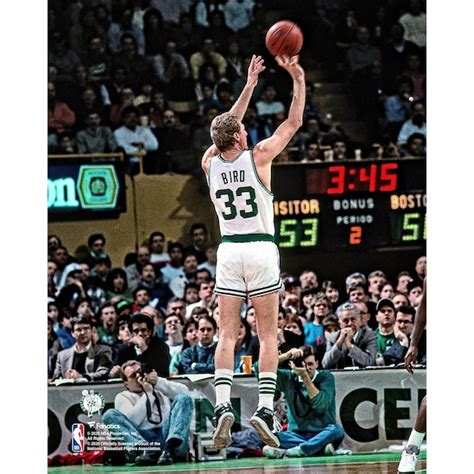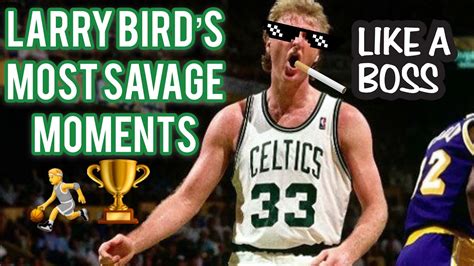
Larry Bird unequivocally favors the three-point shot over the dunk, stating, “Three is better. Period,” highlighting his belief in the strategic advantage the three-pointer provides in modern basketball.
Hall of Famer Larry Bird has definitively weighed in on the enduring debate between the spectacle of a dunk and the strategic value of a three-pointer, firmly siding with the latter. In a recent interview, Bird made his stance crystal clear, proclaiming, “Three is better. Period.” This declaration underscores Bird’s long-held belief in the mathematical and strategic superiority of the three-point shot in the modern NBA, a sentiment that resonates with many analysts and coaches in today’s game. Bird’s comment, delivered with his characteristic directness, arrives amid ongoing discussions about the evolution of basketball and the increasing reliance on perimeter shooting.
Bird, a legend known for his all-around game and exceptional shooting ability, especially from beyond the arc, wasn’t always playing in an era that valued the three-point shot as highly as it is today. When he entered the NBA in 1979, the three-point line was still relatively new, having been adopted by the league just the season before. While Bird was an immediate success, known for his clutch shooting and overall brilliance, the three-pointer was more of a novelty than a cornerstone of offensive strategy. Over the years, however, Bird witnessed and participated in the gradual shift towards emphasizing the three-point shot, eventually becoming a proponent of its importance.
His perspective carries significant weight, considering his storied career with the Boston Celtics, during which he won three NBA championships, three MVP awards, and two Finals MVP awards. Bird’s era was defined by rivalries, most notably with Magic Johnson and the Los Angeles Lakers, but also by the evolving strategies on the court. His ability to adapt and excel in this changing landscape underscores his deep understanding of basketball.
The modern NBA is increasingly dominated by three-point shooting, with teams prioritizing spacing and perimeter shots. This evolution has been driven by statistical analysis showing that three-point shots, despite being inherently more difficult to make than two-point shots, offer a higher expected point value due to the extra point awarded. This has led to offensive systems designed to create open looks from beyond the arc and players honing their three-point shooting skills.
Bird’s emphatic endorsement of the three-pointer reflects this shift. He recognizes that in today’s NBA, the ability to consistently knock down three-point shots is crucial for success. A team that can spread the floor and make threes forces opposing defenses to stretch, creating opportunities for drives to the basket and open looks for other players. This offensive versatility is a hallmark of successful teams in the modern era.
While dunks certainly have their place in basketball, providing highlight-reel moments and energizing crowds, Bird’s comment suggests he views them as less strategically valuable than three-pointers. A dunk is worth two points, the same as a regular field goal inside the arc, but often requires a greater degree of athleticism and carries a higher risk of turnovers or offensive fouls. A successful three-pointer, on the other hand, yields an extra point and forces defenses to adjust their strategy, potentially creating further scoring opportunities.
The discussion about dunks versus three-pointers also touches on the changing aesthetics of basketball. While dunks are undeniably exciting and visually appealing, the modern game often values efficiency and strategic advantage over pure entertainment. The emphasis on three-point shooting reflects this shift, with teams prioritizing high-percentage shots and maximizing their scoring potential.
Bird’s comments are likely to spark further debate among basketball fans and analysts, many of whom hold strong opinions on the relative merits of dunks and three-pointers. Some fans may argue that dunks are more exciting and contribute more to the overall spectacle of the game, while others may agree with Bird that three-pointers are more strategically valuable.
Ultimately, both dunks and three-pointers have their place in basketball. Dunks provide excitement and energy, while three-pointers offer a strategic advantage. However, Bird’s comments highlight the increasing importance of the three-point shot in the modern NBA and underscore the league’s evolution towards a more perimeter-oriented game. His concise statement, “Three is better. Period,” encapsulates this sentiment and serves as a reminder of the strategic value of the three-pointer. The influence of analytics in today’s game cannot be overstated, and Bird’s acknowledgment of the three-pointer’s superiority aligns with the data-driven approaches that many teams now embrace. His perspective, rooted in decades of experience and a deep understanding of the game, carries significant weight in these discussions.
In conclusion, Larry Bird’s assertion that “Three is better. Period” succinctly captures the modern NBA’s strategic emphasis on the three-point shot, highlighting its superior point value and the offensive versatility it provides compared to dunks. While dunks remain a thrilling aspect of the game, Bird’s perspective reflects the data-driven reality that prioritizes efficiency and maximizing scoring opportunities in today’s basketball landscape.
Expanded Analysis and Background
Larry Bird’s straightforward declaration about the superiority of the three-pointer is more than just a casual opinion; it’s a reflection of the NBA’s transformative journey over the past four decades. To fully appreciate his sentiment, it’s essential to delve into the historical context, statistical revolution, and evolving philosophies that have shaped the modern game.
The Three-Point Shot: A Historical Perspective
The three-point shot wasn’t always a central feature of basketball. It was first introduced in the American Basketball League (ABL) in 1961, and later adopted by the ABA in 1967 before making its way to the NBA in 1979, the year Bird joined the league. Initially, the three-pointer was seen as a gimmick or a desperation play, rather than an integral part of offensive strategy. Coaches and players were hesitant to fully embrace it, often viewing it as a risky shot that could disrupt offensive flow.
In Bird’s early years, the three-point line was present, but its usage was limited. Teams primarily focused on inside play and mid-range shots, with the three-pointer reserved for specific situations, such as end-of-quarter heaves or attempts to quickly close a gap in scoring. Players like Bird, however, recognized the potential of the three-pointer and began to incorporate it into their game, albeit cautiously.
The Statistical Revolution and Its Impact
The rise of analytics in basketball has profoundly altered how teams approach the game. Advanced statistical metrics, such as effective field goal percentage (eFG%), true shooting percentage (TS%), and points per possession (PPP), have provided a more nuanced understanding of offensive efficiency. These metrics have demonstrated that the three-point shot, despite its lower success rate compared to shots closer to the basket, offers a higher expected point value due to the extra point awarded.
The adoption of analytics has led to a shift in offensive philosophy. Teams now prioritize spacing the floor and creating open looks from beyond the arc. Coaches design plays specifically to generate three-point opportunities, and players dedicate countless hours to honing their shooting skills. The result is a league where three-point shooting has become an essential component of success.
Bird’s Evolving Perspective
Larry Bird’s perspective on the three-pointer has likely evolved over time. While he was always a capable shooter from beyond the arc, his early focus was on all-around excellence. As the NBA embraced the three-pointer more fully, Bird likely recognized its increasing strategic value and incorporated it more prominently into his game. His ability to adapt to the changing landscape of the NBA underscores his deep understanding of the game and his willingness to embrace new strategies.
Bird’s statement about the three-pointer being “better” is a reflection of this evolution. He recognizes that in today’s NBA, the ability to consistently knock down three-point shots is crucial for success. A team that can spread the floor and make threes forces opposing defenses to stretch, creating opportunities for drives to the basket and open looks for other players. This offensive versatility is a hallmark of successful teams in the modern era.
The Dunk vs. The Three-Pointer: A Strategic Comparison
While dunks are undeniably exciting and visually appealing, Bird’s comment suggests he views them as less strategically valuable than three-pointers. A dunk is worth two points, the same as a regular field goal inside the arc, but often requires a greater degree of athleticism and carries a higher risk of turnovers or offensive fouls. A successful three-pointer, on the other hand, yields an extra point and forces defenses to adjust their strategy, potentially creating further scoring opportunities.
Consider a scenario where a team has two options: a contested dunk or an open three-pointer. Statistically, the open three-pointer is the more advantageous choice. Even if the player only makes 35% of their three-point attempts, the expected value (1.05 points per attempt) is higher than the expected value of a contested dunk, which is likely to have a lower success rate.
The Aesthetic Shift in Basketball
The discussion about dunks versus three-pointers also touches on the changing aesthetics of basketball. While dunks are undeniably exciting and visually appealing, the modern game often values efficiency and strategic advantage over pure entertainment. The emphasis on three-point shooting reflects this shift, with teams prioritizing high-percentage shots and maximizing their scoring potential.
This is not to say that dunks are no longer valued. They still provide highlight-reel moments and can energize a team and its fans. However, in the context of overall offensive strategy, the three-pointer has emerged as the more important weapon.
The Impact on Player Development
The emphasis on three-point shooting has also had a significant impact on player development. Young players are now encouraged to develop their shooting skills from a young age. Coaches emphasize proper shooting technique and provide opportunities for players to practice their three-point shots. As a result, the league is seeing an increasing number of players who are capable of consistently knocking down three-pointers.
This trend is likely to continue in the future, with three-point shooting becoming an even more important skill for NBA players. Players who can shoot from beyond the arc are more valuable than ever, as they provide spacing and offensive versatility.
Criticisms and Counterarguments
While the three-point shot has become an integral part of the NBA, it has also faced criticism. Some argue that the emphasis on three-point shooting has made the game less exciting and more predictable. They argue that the constant barrage of three-pointers has diminished the importance of other aspects of the game, such as post play and mid-range shooting.
Others argue that the three-point shot has made the game more accessible to players of all sizes and skill sets. They argue that it allows smaller players to compete effectively against larger players and that it rewards skill and precision over pure athleticism.
Ultimately, the debate over the three-point shot is a matter of personal preference. Some fans will always prefer the excitement of a dunk, while others will appreciate the strategic value of the three-pointer. However, there is no denying that the three-point shot has fundamentally changed the game of basketball and that it is likely to remain a central feature of the NBA for years to come.
Larry Bird’s Legacy and Influence
Larry Bird’s legacy extends beyond his individual accomplishments. He was a pioneer of the modern NBA, helping to popularize the game and elevate it to new heights. His all-around skills, competitive spirit, and deep understanding of the game made him one of the most influential players in NBA history.
Bird’s endorsement of the three-point shot reflects his commitment to innovation and his willingness to embrace new strategies. His perspective carries significant weight, considering his storied career and his deep understanding of the game. His concise statement, “Three is better. Period,” encapsulates the modern NBA’s strategic emphasis on the three-point shot and serves as a reminder of its importance.
Conclusion: The Enduring Debate
The debate between dunks and three-pointers is likely to continue for years to come. Both have their place in basketball, providing different forms of excitement and strategic value. However, Larry Bird’s comments highlight the increasing importance of the three-point shot in the modern NBA and underscore the league’s evolution towards a more perimeter-oriented game. His perspective, rooted in decades of experience and a deep understanding of the game, carries significant weight in these discussions. The three-pointer has fundamentally changed the game, and its impact is likely to continue to shape the NBA for years to come.
FAQ Section
1. Why does Larry Bird believe the three-pointer is better than a dunk?
Larry Bird believes the three-pointer is “better” primarily due to its higher point value. A three-pointer is worth three points, while a dunk is worth two. This extra point gives teams a strategic advantage, as successful three-point attempts can lead to more efficient scoring and force defensive adjustments. He likely also considers the spacing and offensive versatility that a good three-point shooting team provides, opening up driving lanes and creating more scoring opportunities.
2. Has the NBA always valued the three-point shot?
No, the three-point shot wasn’t always valued as highly as it is today. When it was first introduced to the NBA in 1979, it was often seen as a novelty or a desperation play. Over time, as statistical analysis demonstrated its strategic value, and as players developed their three-point shooting skills, the shot became an integral part of offensive strategy.
3. How has the rise of analytics influenced the importance of the three-pointer?
The rise of analytics has significantly increased the importance of the three-pointer. Advanced statistical metrics have shown that three-point shots, despite their lower success rate compared to shots closer to the basket, offer a higher expected point value. This has led to teams prioritizing spacing and creating open looks from beyond the arc.
4. Does the emphasis on three-point shooting mean dunks are no longer important?
No, dunks are still important in basketball. They provide excitement, energize teams and fans, and can be momentum-changing plays. However, from a purely strategic perspective, Bird’s statement highlights the modern NBA’s preference for the higher point value and offensive versatility that the three-pointer offers. Dunks may provide a spark, but three-pointers often contribute more directly to a team’s overall scoring efficiency.
5. What impact has the focus on three-point shooting had on player development?
The focus on three-point shooting has led to a greater emphasis on developing shooting skills at a young age. Players are now encouraged to practice their three-point shots and improve their shooting technique. This has resulted in a league with a higher percentage of players who are capable of consistently knocking down three-pointers. It’s changed the way players train and the skills that are prioritized in basketball development programs.
6. How did Larry Bird adapt his game to the three-point shot over his career?
Larry Bird entered the NBA when the three-point shot was still relatively new. While already a capable shooter, the emphasis on the three-pointer increased during his career. He likely incorporated it more into his offensive repertoire as he recognized its strategic value, adapting his game to the evolving landscape of the NBA. He leveraged his shooting ability and basketball IQ to exploit defenses and create scoring opportunities from beyond the arc.
7. What criticisms are there of the modern NBA’s reliance on the three-point shot?
Some critics argue that the emphasis on three-point shooting has made the game less exciting and more predictable, diminishing the importance of other aspects of the game, such as post play and mid-range shooting. They feel it has led to a less diverse and more homogenized offensive style across the league.
8. How does Larry Bird’s statement reflect the evolution of basketball strategy?
Bird’s statement encapsulates the modern NBA’s strategic emphasis on the three-point shot, highlighting its superior point value and the offensive versatility it provides. It represents a shift from a more inside-out game to a perimeter-oriented one, driven by statistical analysis and a focus on efficiency. His perspective underscores the data-driven reality that prioritizes maximizing scoring opportunities.
9. Beyond points, what other strategic advantages does the three-pointer offer?
Beyond its higher point value, the three-pointer offers strategic advantages such as spacing the floor, forcing defensive rotations, and creating opportunities for driving lanes and inside scoring. A team’s ability to consistently hit three-pointers makes them more difficult to defend, as opposing teams must stretch their defense and risk leaving other players open.
10. How does Larry Bird’s perspective differ from someone who prioritizes the excitement of a dunk?
Larry Bird’s perspective prioritizes strategic value and offensive efficiency, while someone who prioritizes the excitement of a dunk values the visual spectacle and energy it brings to the game. Bird focuses on maximizing scoring opportunities and creating a more advantageous offensive system, whereas the dunk enthusiast may prioritize entertainment and highlight-reel moments. It’s a difference between appreciating strategic advantage versus pure athletic display.
11. How has the emphasis on the three-point shot affected coaching strategies in the NBA?
Coaches now design plays specifically to generate three-point opportunities. They emphasize spacing, ball movement, and creating open looks for their shooters. They also prioritize defensive strategies that aim to limit the opponent’s three-point attempts. The focus has shifted to maximizing possessions and ensuring that each possession has a high probability of resulting in points, often through the three-point shot.
12. How important is it for young players to develop their three-point shooting skills to succeed in the NBA today?
It’s extremely important. In today’s NBA, players who can consistently shoot from beyond the arc are highly valued. The ability to space the floor and knock down three-pointers makes a player more versatile and valuable to any team. Developing these skills early is crucial for young players hoping to make it in the NBA.
13. How has the defensive approach changed to counter the rise of the three-point shot?
Defensive strategies have adapted to prioritize limiting open three-point attempts. Teams employ various defensive schemes, such as switching, hedging, and aggressive closeouts, to contest shots from beyond the arc. Defenders are often instructed to stay close to shooters and deny them easy looks.
14. What is the impact of analytics beyond the three-point shot in basketball?
Analytics have impacted various aspects of basketball beyond just the three-point shot. They are used to evaluate player performance, optimize rotations, analyze opponent tendencies, and make informed decisions about everything from play calling to roster construction. Data-driven insights are now a fundamental part of team strategy and management.
15. Is there a risk of the NBA becoming too reliant on the three-point shot?
Some argue that there is a risk of over-reliance on the three-point shot, potentially leading to a more predictable and less exciting game. Balancing three-point shooting with other offensive strategies, such as inside play and mid-range shooting, is important for maintaining diversity and excitement in the game. The key is finding the optimal mix of different offensive approaches.
16. In what ways does a strong three-point shooting team change the opponent’s defensive strategy?
A strong three-point shooting team forces the opposing defense to extend further out, creating driving lanes for slashers and opportunities for post players. The defense must constantly rotate and close out on shooters, leaving gaps that can be exploited. This makes the defense more vulnerable and creates more scoring opportunities for the offensive team.
17. How does Larry Bird’s emphasis on the three-point shot reflect his overall basketball philosophy?
Larry Bird’s emphasis on the three-point shot reflects his commitment to playing smart, efficient basketball. He always valued making the right play and maximizing scoring opportunities. His endorsement of the three-pointer aligns with his overall philosophy of prioritizing strategic advantage and making the most of every possession.
18. Is the three-point shot equally valuable for all players and positions?
While valuable for all players, the three-point shot’s strategic importance may vary slightly depending on position and player skill set. For example, a center who can consistently hit three-pointers can significantly stretch the floor and create more space for the offense. Guards typically need to be proficient three-point shooters to be effective in the modern NBA.
19. What are some examples of teams that have successfully utilized the three-point shot to win championships?
The Golden State Warriors, led by Steph Curry and Klay Thompson, are a prime example of a team that has successfully utilized the three-point shot to win championships. The San Antonio Spurs, with their emphasis on ball movement and spacing, have also been successful in leveraging the three-point shot. These teams demonstrated that a well-executed three-point offense can be a potent weapon in the NBA.
20. How might the game of basketball continue to evolve concerning the three-point shot in the future?
The game of basketball may continue to evolve with even more emphasis on the three-point shot, possibly with experimentation with a four-point line or variations in the three-point line distance. Players will likely continue to refine their shooting skills and teams will develop more sophisticated strategies for generating three-point opportunities. The future will depend on maintaining a balance between three-point shooting and other aspects of the game.









